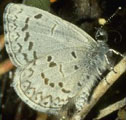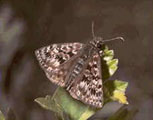Native Plants
Search for native plants by scientific name, common name or family. If you are not sure what you are looking for, try the Combination Search or our Recommended Species lists.
Ceanothus americanus
Ceanothus americanus L.
New Jersey Tea, Redroot
Rhamnaceae (Buckthorn Family)
Synonym(s): Ceanothus americanus var. intermedius, Ceanothus americanus var. pitcheri, Ceanothus intermedius
USDA Symbol: ceam
USDA Native Status: L48 (N), CAN (N)
New Jersey Tea is a low, upright, deciduous shrub that often grows to only 3 ft. tall. Pubescent leaves give the entire plant a grayish cast. Small white flowers occur in 2 in., branch-tip clusters. A low shrub with tiny white flowers in oval clusters rising from the leaf axils on the new shoots. The base is woody, while the upper portion of the plant is made up of herbaceous, spreading branches. Fall color is insignificant.
The dried leaves of this nitrogen-fixing shrub make an excellent tea that was very popular during the Revolutionary War period. Smaller Redroot (C. herbaceus), with flowers in a globose cluster and narrower leaves, ranges from Manitoba and western Quebec to western Maine, south to western Georgia, west to Alabama, Arkansas, and Texas. Small-leaved Redroot (C. microphyllus), has tiny leaves, less than 1/2 of an inch (1.3 cm) long, and occurs in sandy pine or oak woods in the South.
Plant Characteristics
Duration: PerennialHabit: Shrub
Leaf Retention: Deciduous
Leaf Complexity: Simple
Fruit Type: Capsule
Size Notes: Normally no more than 3 feet tall, but can reach 5 feet.
Leaf: Green
Autumn Foliage: yes
Flower: Flowers in 2 inch heads.
Fruit: Brown
Bloom Information
Bloom Color: WhiteBloom Time: Mar , Apr , May , Jun , Jul , Aug
Distribution
USA: AL , AR , CT , DC , DE , FL , GA , IA , IL , IN , KS , KY , LA , MA , MD , ME , MI , MN , MO , MS , NC , NE , NH , NJ , NY , OH , OK , PA , RI , SC , TN , TX , VA , VT , WI , WVCanada: MB , NB , ON , QC
Native Distribution: Que. to FL, w. to MN, e. NE, e. KS & TX
Native Habitat: Open, deciduous woods; woodland edges; oak savannas; mesic or dry prairies; roadsides
Growing Conditions
Water Use: Low , MediumLight Requirement: Sun , Part Shade
Soil Moisture: Dry , Moist
Soil pH: Circumneutral (pH 6.8-7.2)
CaCO3 Tolerance: Medium
Drought Tolerance: High
Cold Tolerant: yes
Soil Description: Well-drained, mesic sand, loam, or limey soils. Sandy, Sandy Loam, Medium Loam, Limestone-based
Conditions Comments: This extremely adaptable species can withstand inhospitable conditions because of massive, deep roots. It is quick to recover after fire.
Benefit
Use Ornamental: Ground cover, Rocky hillside, Low growing, Planned landscapeUse Wildlife: Butterflies use flowers. Turkeys and quail consume seeds.
Use Food: The dried leaves of this nitrogen-fixing shrub make an excellent tea that was very popular during the Revolutionary War period. (Niering)
Conspicuous Flowers: yes
Attracts: Birds , Butterflies
Larval Host: Spring Azure, Summer Azure, Mottled Duskywing
Nectar Source: yes
Value to Beneficial Insects
Special Value to Native BeesSupports Conservation Biological Control
This information was provided by the Pollinator Program at The Xerces Society for Invertebrate Conservation.
Butterflies and Moths of North America (BAMONA)
|
Spring Azure (Celastrina "ladon" )  Larval Host |
Mottled Duskywing (Erynnis martialis)  Larval Host |
Summer Azure (Celastrina neglecta)  Larval Host |
Propagation
Propagation Material: Seeds , Semi-hardwood Cuttings , Softwood CuttingsSeed Collection: Collect seeds in late summer and early fall. Because dry capsules disperse their seed abruptly with a sudden ejection, it may be necessary to tie cloth bags around the clusters of capsules to catch the seeds.
Seed Treatment: Scarification may be necessary and can be accomplished by soaking the seeds in hot water (180-200 degrees). Soak in cooling water 24 hours. Stratify all seeds for 60-90 days at 41 degrees.
Commercially Avail: yes
Find Seed or Plants
View propagation protocol from Native Plants Network.
Mr. Smarty Plants says
Shrub for part shade for hedge in Holly Ridge NC
April 07, 2010
We live in Coastal NC. We would like a type of shrub for the front of our home which is partial shade, similar style to a boxwood or trainable hedge. What NC native would compare?
view the full question and answer
Attracting butterflies in Tennessee
July 03, 2009
What flowers and plants do the caterpillars in Tennessee eat? And do you know what butterflies live in Tipton Co. Tennessee?
view the full question and answer
Groundcover to reduce erosion for shady area in New York
May 05, 2009
We live on a lake with gravelly and clay soils, lots of wind and little sun. I am looking for a native ground cover that will help reduce erosion over some of the steep slopes facing south (under shad...
view the full question and answer
Native plants to stabilize a steep bank in Pennsylvania
April 23, 2008
I would like to use native plantings to stabilize a steep bank of a septic leach field in eastern Pennsylvania. My purpose is to control erosion and to eliminate the need for mowing. What would you r...
view the full question and answer
From the National Organizations Directory
According to the species list provided by Affiliate Organizations, this plant is on display at the following locations:Delaware Nature Society - Hockessin, DE
Crosby Arboretum - Picayune, MS
Mt. Cuba Center - Hockessin, DE
Bibliography
Bibref 1186 - Field Guide to Moths of Eastern North America (2005) Covell, C.V., Jr.Bibref 1185 - Field Guide to Western Butterflies (Peterson Field Guides) (1999) Opler, P.A. and A.B. Wright
Bibref 946 - Gardening with Prairie Plants: How to Create Beautiful Native Landscapes (2002) Wasowski, Sally
Bibref 199 - National Audubon Society Field Guide to North American Wildflowers : Eastern Region (2001) J. W. Thieret; W. A. Niering; N. C. Olmstead
Bibref 841 - Native Alternatives to Invasive Plants (2006) Burrell, C. C.
Bibref 318 - Native Texas Plants: Landscaping Region by Region (2002) Wasowski, S. & A. Wasowski
Bibref 1294 - The Midwestern Native Garden: Native Alternatives to Nonnative Flowers and Plants An Illustrated Guide (2011) Adelman, Charlotte and Schwartz, Bernard L.
Search More Titles in Bibliography
Web Reference
Webref 57 - Atlas of Florida Plants (2020) Institute for Systematic BotanyWebref 38 - Flora of North America (2019) Missouri Botanical Garden, St. Louis, MO & Harvard University Herbaria, Cambridge, MA.
Webref 23 - Southwest Environmental Information Network (2009) SEINet - Arizona Chapter
Additional resources
USDA: Find Ceanothus americanus in USDA PlantsFNA: Find Ceanothus americanus in the Flora of North America (if available)
Google: Search Google for Ceanothus americanus
Metadata
Record Modified: 2023-05-04Research By: TWC Staff